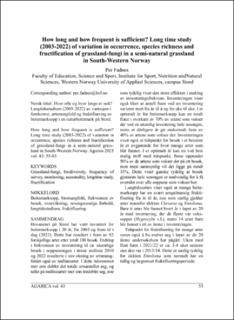| dc.description.abstract | The semi natural grassland described in this paper, Hovaneset in Stord municipality, South- Western Norway, has been examined for grass- land fungi for 20 years, from 2003 until today (2022). This has resulted in the discovery of 92 different species after a total of 180 visits to the locality. Change in the frequency of survey to approximately a weekly visit during the seasons from 2010 resulted in a large increase in species diversity, also of red-listed species. During these last 13 years of survey, the total number of species more than doubled, and the number of red-listed species more than tripled, which clearly shows the huge effect in changing the frequency of visits to a visit once a week during the season. The survey also clearly shows that the number of finds during a visit varies greatly from year to year and from week to week. In an optimal year for grassland fungi, around 70% of the species that grow there can be found in a weekly survey throughout the season, while a less good year gives a maximum of 40% finds. The survey also shows that the time of visit in a particular year is decisive for how many species are found in one visit. In an optimal year for grassland fungi, at the best possible match with time of survey, you can find up to 50% of the species growing there in one visit, but more likely it will be around 35%. It therefore shows very clearly that visits during the whole season is necessary to get hold on all fungi growing here. The survey also shows that many grass- land fungi have very irregular fructification from one year to the other, which particularly applies to species within the genera Clavaria and Entoloma. Only ten species were found each year during the survey, most of which were waxcaps (Hygrocybe s.l.), while 14 species were only found in one of the years of survey. The time of fruiting also seems to have changed during the 20 years the survey has been ongoing. The week with the highest number of species recorded in 2021/22 is approximately 3-4 weeks later than it was in 2013/14. This is particularly clear for the genus Entoloma, which normally has an early and limited fruiting period. | en_US |
